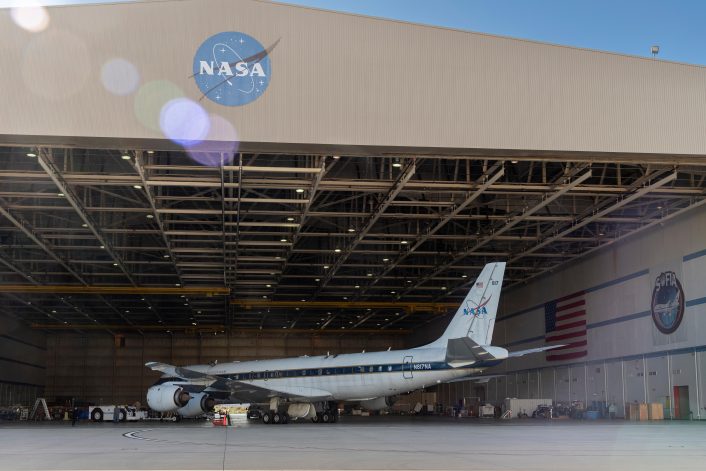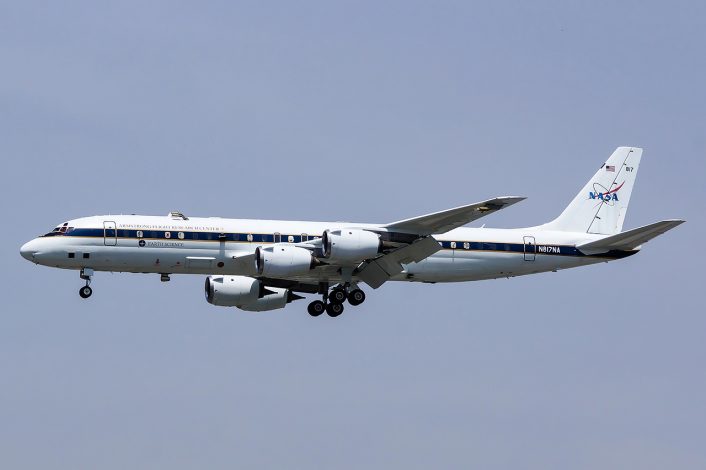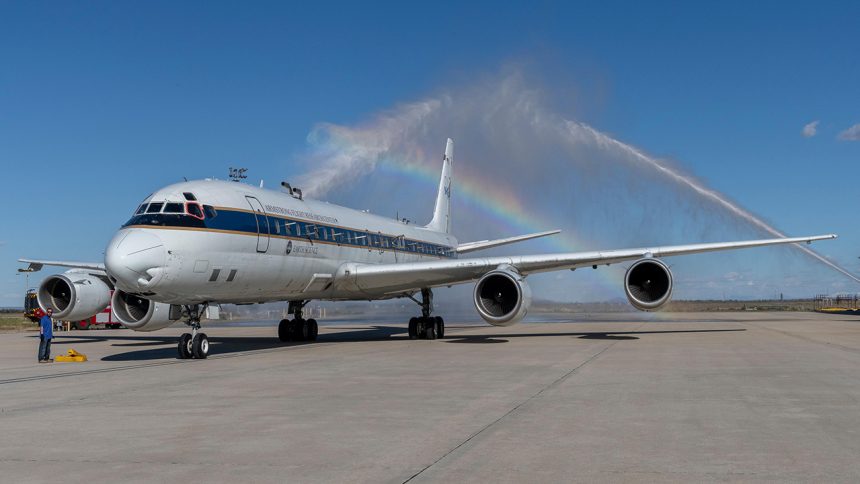After 37 years, NASA is about to retire its DC-8 Airborne Science Laboratory. It will be replaced by a B777-200.
On Apr. 1, 2024, NASA’s DC-8 aircraft, registration N817NA, completed its final mission and landed at the Armstrong Flight Research Center in Palmdale, California. The aircraft is set to retire in May this year, bringing the 37-year career of the Airborne Science Laboratory to an end.
According to the agency, the iconic jet and its crew were welcomed back with a celebratory water salute by the U.S Air Force Plant 42 Fire Department after completing an air quality study, the Airborne and Satellite Investigation of Asian Air Quality, or ASIA-AQ mission.
The end of an era ✈️
After 37 years of successful airborne science missions, NASA’s DC-8 aircraft completed its final mission and is set to retire after concluding operations in May.
Check out where the DC-8 will have its new home after retirement ⬇️ https://t.co/I2TPImFpsE pic.twitter.com/9AoLwZeK5n
— NASA Armstrong (@NASAArmstrong) April 9, 2024
Unique aircraft
The DC-8, the largest flying science laboratory in the world, has been used to support NASA’s Airborne Science mission since 1987. It began its career as a jetline for Italy’s flag company Alitalia back in May 1969. After a decade of service it was sold to Braniff before being acquired by NASA.
It was delivered with registration N717NA to NASA in July 1986 and re-registered as N817NA in June 1998.

It is 157 feet long with a 148-foot wingspan. Its range is 5,400 nautical miles and its operational altitudes are from 1,000 to 42,000 feet. It can remain airborne for 12 hours although its average science missions lasted from 6 to 10 hours. The DC-8 can seat up to 45 researchers and flight crew and carry 30,000 pounds of scientific instruments and equipment.
According to NASA, data gathered with the aircraft at flight altitude, and by remote sensing, have been used for studies in archaeology, ecology, geography, hydrology, meteorology, oceanography, volcanology, atmospheric chemistry, cryospheric science, soil science, and biology.
In 2016, the aircraft deployed on Atmospheric Tomography Mission (ATom-1) to study the impact of human-produced air pollution on greenhouse gases and on chemically reactive gases in the atmosphere.

Four types of missions
The NASA page dedicated to the type lists four types of missions flown with the DC-8:
- sensor development,
- satellite sensor verification,
- space vehicle launch or re-entry telemetry data retrieval and optical tracking
- other research studies of Earth’s surface and atmosphere.
Sensor development
Since the DC-8 operates within Earth’s atmosphere, it provides a cost-effective means to experiment and confirm the functionality of prototype satellite instruments. Scientists use the DC-8 to refine concepts in instrument technology, try new instruments, and make necessary adjustments based on flight data. This proactive approach allows for the identification and fixing of potential issues before deploying new instruments into space. Consequently, usung flight-proven hardware can result in significant savings of both time and resources.
“The DC-8 conducted the Active Sensing of CO2 Emissions over Nights, Days and Seasons (AS-CENDS) campaign during the winter of 2016 to demonstrate improved airborne lidar instrument performance used in gathering remote measurements of atmospheric carbon dioxide. Flights were flown over different land features – ocean, urban, tall forests, and snow – to test surface reflectance effects on instrument performance,” NASA website says.
“Space-borne lasers would find the same type of surfaces when used to study components of the Earth’s atmosphere. This research will contribute to further development of laser-based Earth-observing satellite instruments designed to measure atmospheric carbon dioxide.”
Satellite sensor verification
The DC-8 plays a crucial role in assisting scientists to validate the accuracy of data and refine the interpretation of satellite instrument readings. During these missions, the DC-8 follows the trajectory of a satellite, gathering data using its own instruments to cross-check the information collected from space. This comparative analysis enables scientists to assess and refine algorithms used to interpret satellite data, ensuring they accurately reflect the findings verified with DC-8 instrumentation.
“The Convective Processes Experiment – Aerosols and Winds (CPEX-AW) campaign was a joint effort between NASA and the European Space Agency (ESA) in 2021. The primary goal was to conduct post-launch calibration and validation activities of the Atmospheric Dynamics Mission-Aeolus (ADM-AEOLUS) Earth observation wind lidar satellite in St. Croix, U.S. Virgin Islands. The CPEX-AW campaign was a follow-on effort to the Convective Processes Experiment (CPEX) field campaign, which took place in summer 2017”.
Space Vehicle Launch/Re-entry Telemetry and Tracking
To support the launches of the Missile Defense Agency’s Space Tracking and Surveillance Demonstration satellite and NASA’s Glory Earth science satellite, a tracking antenna was installed in the front section of the DC-8. This antenna was specifically designed to receive telemetry data from the launch vehicles, enhancing support capabilities for these missions.
“The DC-8 has also supported optical tracking of spacecraft re-entering the Earth’s atmosphere. This includes the re-entry of the European Automated Transfer Vehicle dubbed “Jules Verne” in 2008, and the 2010 Japan Aerospace Exploration Agency mission to track the re-entry of the Hayabusa spacecraft”, NASA website explains.
Other research studies
In 1991, NASA launched a comprehensive program to study Earth as an environmental system and the DC-8 has supported it thanks to its endurance, large payload capacity, and laboratory environment.
In 2009, the DC-8 took part in Operation IceBridge, NASA’s annual polar ice field campaign, with flights over Antarctica from a deployment base at Punta Arenas, Chile.
“The aircraft carried researchers and their instruments over western Antarctica in the largest airborne survey of Earth’s polar ice to date. During March and April 2010, the DC-8 was based in Greenland for IceBridge’s Arctic ice study. IceBridge’s research continued the multi-year measurements started by NASA’s Ice, Cloud and Land Elevation Satellite (ICESat-I), which ceased operation in 2009, and was completed in 2019 with the launch of ICESat-II.”
“The DC-8 was fitted with 32 sensors for a 2019 mission to investigate wild and prescribed burn fires in the northwest. Fire Influence on Regional to Global Environments – Air Quality (FIREX-AQ) was a joint effort between NASA and the National Oceanic and Atmospheric Administration (NOAA). The DC-8 operated from Boise, Idaho, and Salina, Kansas, during the campaign, and drew together coordinated observations from NASA and NOAA satellites, aircraft (including NASA’s ER-2 and NOAA’s Twin Otter and Night Fox uncrewed aircraft system), and mobile ground laboratories and sites.”
What’s next?
The DC-8 will continue its educational legacy as it retires to its new home at Idaho State University in Pocatello, Idaho, where it will be used to train future aircraft technicians by providing real-world experience in the college’s Aircraft Maintenance Technology Program.
In 2022, NASA purchased a DC-8 replacement aircraft: a B777-200ER formerly operated by Japan Airlines. The aircraft flew to Langley Research Center on Dec. 15, 2022, to support the start of research modifications. The schedule is for the “new” aircraft to fly its first science mission in 2025.









